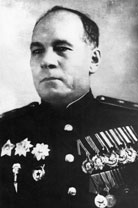
The 97th Guards Mechanized Brigade was a rifle, and then a motor-rifle division of the Soviet Union's Army, before becoming a mechanized brigade of the Ukrainian Ground Forces, based in Slavuta in western Ukraine.
The 4th Airborne Corps was an airborne corps of the Red Army in World War II. It fought in the Vyazma airborne operation, an unsuccessful landing during the Rzhev-Vyazma Offensive.

The 4th Guards Airborne Division was an airborne division of the Red Army that fought as infantry during World War II.
The 2nd Guards Airborne Division was a division of the Red Army during World War II.
The 3rd Guards Airborne Division was a Red Army division of World War II. In December 1945 it appears to have become 125th Guards Rifle Division, while serving with 35th Guards Rifle Corps, 27th Army, Carpathian Military District.
The 6th Guards Airborne Division was a Red Army airborne division that fought as infantry during World War II.
The 32nd Guards Tank Division was a tank formation of the Soviet Army/Soviet Ground Forces. Its predecessor, the 9th Guards Airborne Division, was a Red Army Airborne division of World War II. On 19 June 1945, it became the 116th Guards Rifle Division. In 1946, it became the 14th Guards Mechanized Division. In 1957, it became the 14th Guards Motorized Rifle Division. In 1982, it became the 32nd Guards Tank Division, which was disbanded in June 1989.
The 126th Guards Rifle Division was a Red Army division from 1945 to 1946, part of the Southern Group of Forces. The 126th Guards Rifle Division was originally the 10th Guards Airborne Division, which was transformed into a rifle division on 20 December 1945.
The 105th Guards Airborne Division was an airborne division of the Soviet Airborne Troops.

Mikhail Denisenko was a Red Army Major general and Hero of the Soviet Union. He fought in World War II with the Soviet airborne, leading the 36th Guards Rifle Division and 12th Guards Airborne Division. Postwar, Denisenko commanded the 103rd Guards Airborne Division, before his death in 1949 in a parachute accident.

Ivan Ivanovich Zatevakhin was a Red Army Lieutenant general who commanded the Soviet Airborne Forces (VDV) from 1944 to 1946.

Alexander Fyodorovich Kazankin was a Red Army Lieutenant general who commanded the Soviet airborne. He fought in the Russian Civil War and graduated from the Frunze Military Academy in 1934. Kazankin led the 4th Airborne Corps during the Vyazma airborne operation. He later commanded the 1st Guards Airborne Division, 16th Guards Airborne Division, 12th Guards Rifle Corps and 39th Guards Rifle Corps. Kazankin became the Soviet airborne commander in October 1947, but was demoted to deputy commander in December 1948. After briefly becoming airborne forces commander again between January and March 1950, Kazankin successively became inspector general of the airborne forces and then deputy airborne forces inspector general before his death on 20 March 1955.
The 3rd Airborne Corps was an airborne corps of the Red Army in World War II. The corps was established near Kiev.
The 1st Airborne Corps was an airborne corps of the Red Army during World War II. It fought in the Battle of Kiev, the Battle of Moscow and in the Battle of Demyansk.
The 37th Guards Rifle Division was an infantry division of the Red Army which fought during World War II.
Viktor Grigoryevich Zholudev was a Red Army major general and posthumous Hero of the Soviet Union. Zholudev fought in the 1929 Sino-Soviet conflict, the Battle of Lake Khasan in 1938 and the 1939 Battles of Khalkhin Gol, as well as World War II. Zholudev commanded the 37th Guards Rifle Division during its defense of the Stalingrad tractor factory during the Battle of Stalingrad.
The 295th Rifle Division was an infantry division of the Soviet Union's Red Army and later the Soviet Army, formed twice.
The 212th Airborne Brigade was an airborne brigade of the Soviet Airborne Troops, formed twice.




